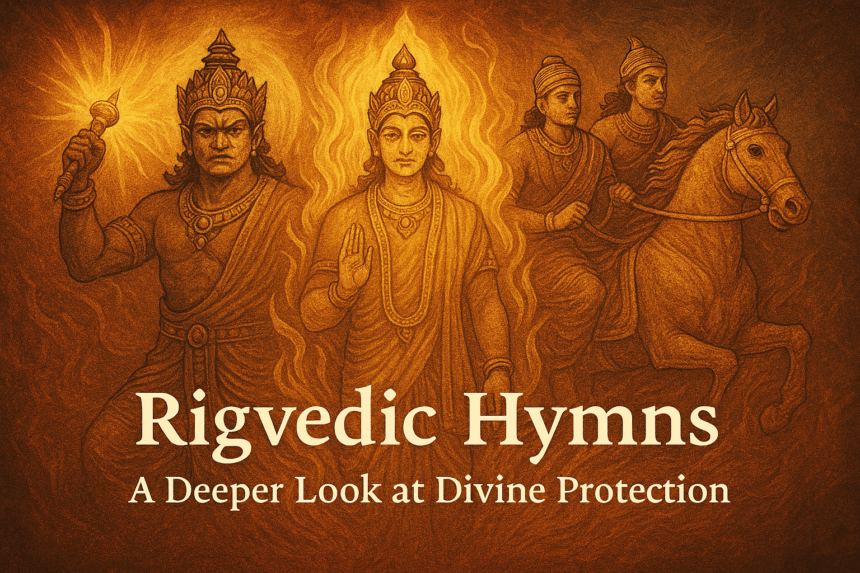Rigvedic Hymns: A Deeper Look at Divine Protection
Part VII – Vedic Defense Mantras Series: Divine Intervention in Crisis
Introduction
The Rigveda is more than ancient poetry; it is a living scripture that encodes divine responses to human challenges — both material and spiritual. In earlier blogs, we explored how the Vedas offer a civilizational shield through Agni’s purifying fire, Indra’s victorious force, and the Ashvins’ timely rescue. But the Vedas offer more: specific mantras that invoke divine protection, repel adharmic forces, and fortify dharma — not through retaliation, but through invocation.
This blog continues the Vedic Defense Mantras series with select hymns from Rigveda Mandala 1 that seek divine support for protection and the destruction of forces that oppose dharma — whether these are called ashamsa, dasyu, or vidharma. These verses are clear, purposeful, and aligned with the spiritual strategy of the seers: invoking divine strength to defend truth.
Background
The Rigveda, composed by rishis in a time of cosmic and cultural clarity, does not separate spiritual insight from practical survival. Mantras for defense are not expressions of fear but assertions of dharma’s primacy. The deities invoked — such as Indra, Agni, and the Maruts — are not remote entities, but active protectors of ṛta, the universal order.
The earlier blogs have already shown that Hinduism today faces targeted erosion — ideologically, demographically, and spiritually. In that light, returning to these suktas is not ritualism — it is restoration. These verses remind us: Vedic knowledge is not passive; it is protective. This blog focuses on verses that explicitly request divine intervention against adharma and call for protection of the righteous.
Indra & Agni: The Guardians of Cosmic Order
Rigveda 1.21.6 – Original Sanskrit
तेन सचेना जागृतमध चेतुना पदे।
इन्द्राग्नी शम यच्छतम्॥
Translation:
With this conscious accord, awaken in our presence, O Indra and Agni; bestow upon us peace and harmony.
Audio:
[We apologize that we do not have resources to create audio and the audio is not publicly available for this verse. If anyone is volunteering to create or share video for the verse we will be grateful]
This mantra invokes the dual guardianship of Indra and Agni — one the destroyer of obstacles, the other the purifier of all offerings. The prayer is not passive; it calls them to wakefulness, to be conscious participants in our protection. The plea is for śam — a Vedic peace born not from surrender, but from restored balance through divine action.
The Maruts & Indra: Forces of Storm and Victory
Rigveda 1.23.9 – Original Sanskrit
हत वृत्रं सुदानव इन्द्रेण सहसा युजा.
मा नो दुःशंस ईशत
Audio:
By Sri Shyama Sundara Sharma and Sri Satya Krishna Bhatta. Recorded by © 2012 Sriranga Digital Software Technologies Pvt. Ltd. [Credit: https://sri-aurobindo.co.in/ Cut using https://mp3cut.net/]
Translation:
As we choose the righteous divine force, let not the unworthy, the blasphemer, hold dominion over us.
Here, the prayer seeks protection from ashamsa — those who revile truth, who cannot be praised, who threaten dharma not by strength, but by deceit. The hymn’s tone is decisive: we choose asura in its original Vedic sense of divine strength, and we reject those who are ashamsa — unworthy of invocation, yet seeking control.
This verse is not metaphorical; it is direct defense — a spiritual veto on adharmic rule.
Indra: The Destroyer of Malice
Rigveda 1.29.5 – Original Sanskrit
समिन्द्र ग्देभं मृण नुवन्त पापयामुया.
आ तून इन्द्र शंसय गोष्वश्वेषु शुभ्रिषु सहस्रेषु तुवीमध. (५)
सर्व परिक्रोशं जहि जम्भया कृकदाश्वम्,
आ तू न इन्द्र शंसय गोष्वश्वेषु शुभ्रिषु सहस्रेषु तुवीमघ.
Audio:
By Sri Shyama Sundara Sharma and Sri Satya Krishna Bhatta. Recorded by © 2012 Sriranga Digital Software Technologies Pvt. Ltd. [Credit: https://sri-aurobindo.co.in/ Cut using https://mp3cut.net/]
Translation:
He does not accept the wild beast-like, crooked-hearted one. O Indra of wealth, come to us with your thousand-fold gifts.
This verse targets those who act like predatory beasts, cunning and unrighteous, bringing harm through deception and bad intent. The yajamāna, or sacrificer, seeks Indra’s favor to reject such individuals from gaining any foothold in the righteous sphere. The phrase “does not accept” implies divine disapproval and exclusion — a spiritual quarantine for the wicked.
Rigveda 1.29.7 – Original Sanskrit
सर्वम् परिक्रोशं जहि जम्भया कृकदाश्वम्,
आ तू न इन्द्र शंसय गोष्वश्वेषु शुभ्रिषु सहस्रेषु तुवीमघ.
Audio:
By Sri Shyama Sundara Sharma and Sri Satya Krishna Bhatta. Recorded by © 2012 Sriranga Digital Software Technologies Pvt. Ltd. [Credit: https://sri-aurobindo.co.in/ Cut using https://mp3cut.net/]
Translation:
You fill all with bounty, smash the enemy like a serpent. O Indra, grant us supreme peace.
Here, the prayer becomes explicit. Indra is asked to crush the enemy — not metaphorically alone, but in clear Vedic language, likening the enemy to a venomous snake (kṛkadāma). This verse is a yajamāna’s call for cosmic intervention — asking Indra to destroy the disruptive force so that śāntam, peace, may be restored. It reflects an understanding that peace must be defended, and destruction of adharma is a prerequisite for lasting harmony.
Together, these hymns reveal that Vedic protection is not merely personal; it’s civilizational — aligned with ṛta and invoked to safeguard the sacrificer and the dharmic order.
Ashvin Kumars: The Rescuers in Motion
Rigveda 1.30.19 – Original Sanskrit
न्यघन्यस्य मूर्धनि चक्क्रम् रथस्य येमथुः.
परिद्यमन्य परि द्यामन्यदीयते.
Audio:
By Sri Shyama Sundara Sharma and Sri Satya Krishna Bhatta. Recorded by © 2012 Sriranga Digital Software Technologies Pvt. Ltd. [Credit: https://sri-aurobindo.co.in/ Cut using https://mp3cut.net/]
Translation:
When your friendship rides in the chariot, one wheel rests upon the firm mountain, the other orbits near Agni.
This evocative imagery reminds the yajamāna that the Ashvin twins — divine physicians and swift responders — traverse realms to come to the aid of those aligned with sacred fire. Their friendship is not abstract. It manifests as movement, rescue, and divine alignment. Though this verse doesn’t mention enemy destruction, its placement in the defense series is vital — the Ashvins are the first to arrive when threats loom.
Agni: The Axis of Sacrificial Power
Rigveda 1.27.8 – Original Sanskrit
नकिरस्य पर्येत करस्य चित्.
वाजो अस्ति श्रवाय्यः.
Audio:
By Sri Shyama Sundara Sharma and Sri Satya Krishna Bhatta. Recorded by © 2012 Sriranga Digital Software Technologies Pvt. Ltd. [Credit: https://sri-aurobindo.co.in/ Cut using https://mp3cut.net/]
Translation:
Men call upon Agni, praised among men, the well-invoked, the all-knowing hotṛ (priest).
Agni here is not invoked to destroy, but to preserve the link between man and the divine. He is the priest of the sacrifice, the conveyor of offerings, and the symbolic firewall that guards yajñas from corruption. By placing this verse alongside others of destruction, the message is clear: not all defense is violent — Agni defends through sanctification, through ensuring the sacrifice is clean, accepted, and untouched by the impure.
Defense Without Hatred, Invocation Without Fear
These verses don’t encourage retaliation, but they refuse surrender. They are part of a Vedic strategy of survival that sees invoking the Devas as a way to shield the yajamāna, destroy adharma, and maintain cosmic order (ṛta). Indra smashes, the Ashvins rescue, Agni purifies — not to conquer, but to preserve dharma and peace.
Call to Action
These mantras are not echoes of a forgotten past — they are living weapons of clarity. Recite them not just for protection, but for alignment with divine intelligence. Let Indra’s thunder strike falsehood, let Agni purify your inner fire, let the Ashvins come when no one else can.
We have created two videos, one that helps viewer digest the contents of this blog and the other that you must download and play to ward of the enemies around you.
🕉️ Begin your practice today — even one verse at dawn is a shield.
🛡️ Invoke, don’t retaliate. But never stand defenseless.
Let the Rigveda protect you, as it did the yajamānas of old.
Feature Image: Click here to view the image.
Video for Education and Learning about the Blog
Video for daily practice
Glossary of Terms
-
Rigveda: The oldest of the four Vedas in Hinduism, comprising hymns composed in Vedic Sanskrit. It is a foundational spiritual and philosophical text of Sanatana Dharma.
-
Dharma: The cosmic law, duty, and moral order that sustains the universe. It also refers to righteous living aligned with universal principles.
-
Adharma: The opposite of dharma — representing falsehood, injustice, disorder, or unrighteousness that threatens cosmic balance.
-
Agni: The Vedic deity of fire, transformation, and divine communication. He acts as a mediator between humans and gods during yajnas (sacrificial rituals).
-
Indra: The king of the Vedic gods, associated with rain, lightning, warfare, and the protection of truth. He is often invoked to destroy obstacles and enemies of dharma.
-
Ashvin Kumars: Twin Vedic deities known as divine physicians. They symbolize swift intervention, healing, and miraculous rescue from danger.
-
Soma: A sacred Vedic plant and ritual drink, believed to confer immortality and divine insight. Soma is also personified as a deity in the Rigveda.
-
Asura: In early Vedic usage, it meant a powerful divine being or lord. In later contexts, it came to represent beings opposed to dharma (demons), but in many Rigvedic hymns, it retains its original noble sense.
-
Ashamsa: A term used to describe one who speaks ill, blasphemes, or reviles — often representing inner negativity or external falsehood.
-
Kṛkadāma: A symbolic term in Rigveda 1.30.19 representing a serpentine or hostile force—sometimes interpreted metaphorically as a personification of illusion or danger.
-
Ṛta (ऋत): The Vedic principle of cosmic order, truth, and harmony. Precursor to the later concept of dharma, ṛta governs both the natural and moral laws of the universe.
-
Śam (शम्): A Sanskrit term meaning peace, well-being, and inner harmony. Often invoked in Vedic mantras as the ideal state resulting from divine protection.
-
Havya: Offerings made into the sacred fire during Vedic rituals. These offerings are carried to the deities by Agni.
-
Nasatya and Dasra: Epithets of the Ashvin Kumars. Nasatya means ‘truthful one,’ and Dasra means ‘the wondrous’ or ‘miraculous one.’
-
Yajña (यज्ञ): A Vedic sacrificial ritual that involves offerings to deities through fire, recitation of mantras, and collective participation aimed at sustaining cosmic balance.
-
Mantra: Sacred sound or hymn believed to carry vibrational power. In the Vedic context, mantras are precise sonic invocations used for spiritual and protective purposes.
-
Anṛta (अनृत): Falsehood or disorder; that which is against ṛta. Often used to represent adharma or untruth in Rigvedic contexts.
-
Śruti: Literally “that which is heard.” It refers to sacred texts believed to be divinely revealed to ancient rishis, including the Vedas.
-
Sūkta (सूक्त): A hymn or collection of verses, usually addressed to one or more deities, found within the Rigveda and other Vedic texts.
#Rigveda #VedicMantras #DivineProtection #SanatanaDharma #HinduinfoPedia



Leave a Reply